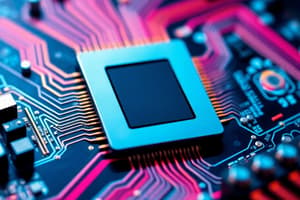Podcast
Questions and Answers
Which of the following is the function of processing in computing?
Which of the following is the function of processing in computing?
- Transmitting results to another destination
- Displaying results to the user
- Saving data for future use
- Performing operations on data (correct)
Which numbering system uses sixteen symbols?
Which numbering system uses sixteen symbols?
- Hexadecimal (correct)
- Binary
- Decimal
- Octal
Which logic gate outputs 1 only if all inputs are 1?
Which logic gate outputs 1 only if all inputs are 1?
- AND Gate (correct)
- XOR Gate
- NOT Gate
- OR Gate
What is the output of a NOT gate if the input is 0?
What is the output of a NOT gate if the input is 0?
Which logic gate outputs 1 if at least one input is 1?
Which logic gate outputs 1 if at least one input is 1?
Which of the following is the best description of a computer?
Which of the following is the best description of a computer?
What is the primary function of the CPU?
What is the primary function of the CPU?
Which type of memory is volatile and loses its data when the computer is turned off?
Which type of memory is volatile and loses its data when the computer is turned off?
Which of the following falls under the category of system software?
Which of the following falls under the category of system software?
What is the function of an operating system (OS)?
What is the function of an operating system (OS)?
Which component performs arithmetic and logical operations in the CPU?
Which component performs arithmetic and logical operations in the CPU?
Which type of storage device uses flash memory and has no moving parts.
Which type of storage device uses flash memory and has no moving parts.
Which of the following is an example of an output device?
Which of the following is an example of an output device?
What is a web browser primarily used for?
What is a web browser primarily used for?
Which architecture uses a single address space for both instructions and data?
Which architecture uses a single address space for both instructions and data?
What is the base of the binary number system?
What is the base of the binary number system?
How many bits are in a byte?
How many bits are in a byte?
Which of the following is a character encoding standard?
Which of the following is a character encoding standard?
What does LAN stand for?
What does LAN stand for?
Which protocol is the foundation of the internet?
Which protocol is the foundation of the internet?
What type of software is designed to harm computer systems?
What type of software is designed to harm computer systems?
What is the purpose of a firewall?
What is the purpose of a firewall?
What is the process of converting data into a coded form to prevent unauthorized access?
What is the process of converting data into a coded form to prevent unauthorized access?
Which of the following is a high-level programming language?
Which of the following is a high-level programming language?
Which type of language is translated into machine code before execution?
Which type of language is translated into machine code before execution?
What is a relational database?
What is a relational database?
What does SaaS stand for in cloud computing?
What does SaaS stand for in cloud computing?
Which of the following is a subset of Artificial Intelligence?
Which of the following is a subset of Artificial Intelligence?
Flashcards
What is a computer?
What is a computer?
An electronic device that manipulates information or data.
What is Hardware?
What is Hardware?
Physical components of a computer. E.g., CPU, memory, storage.
What is Software?
What is Software?
Instructions that tell the computer what to do.
What is System Software?
What is System Software?
Signup and view all the flashcards
What is Application Software?
What is Application Software?
Signup and view all the flashcards
What is the CPU?
What is the CPU?
Signup and view all the flashcards
What is RAM?
What is RAM?
Signup and view all the flashcards
What is ROM?
What is ROM?
Signup and view all the flashcards
Processing (in computing)
Processing (in computing)
Signup and view all the flashcards
Decimal (Base-10)
Decimal (Base-10)
Signup and view all the flashcards
Binary (Base-2)
Binary (Base-2)
Signup and view all the flashcards
AND Gate
AND Gate
Signup and view all the flashcards
NOT Gate
NOT Gate
Signup and view all the flashcards
Web Browser
Web Browser
Signup and view all the flashcards
Von Neumann Architecture
Von Neumann Architecture
Signup and view all the flashcards
Bit
Bit
Signup and view all the flashcards
Byte
Byte
Signup and view all the flashcards
Binary
Binary
Signup and view all the flashcards
ASCII
ASCII
Signup and view all the flashcards
LAN (Local Area Network)
LAN (Local Area Network)
Signup and view all the flashcards
WAN (Wide Area Network)
WAN (Wide Area Network)
Signup and view all the flashcards
Malware
Malware
Signup and view all the flashcards
Viruses
Viruses
Signup and view all the flashcards
Firewalls
Firewalls
Signup and view all the flashcards
Encryption
Encryption
Signup and view all the flashcards
High-Level Languages
High-Level Languages
Signup and view all the flashcards
Database
Database
Signup and view all the flashcards
Cloud Computing
Cloud Computing
Signup and view all the flashcards
Study Notes
The provided text contains the same information as the existing notes, so no updates are needed.
Studying That Suits You
Use AI to generate personalized quizzes and flashcards to suit your learning preferences.
Description
Learn about the fundamental components of a computer, including hardware, software, and firmware. Explore the functions of the CPU, system software, and application software. Understand how these elements work together.



